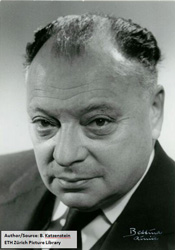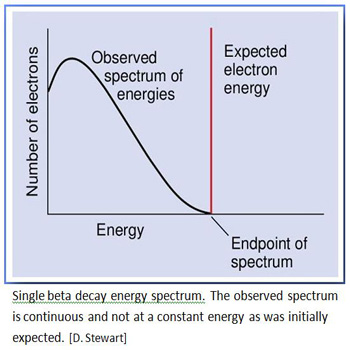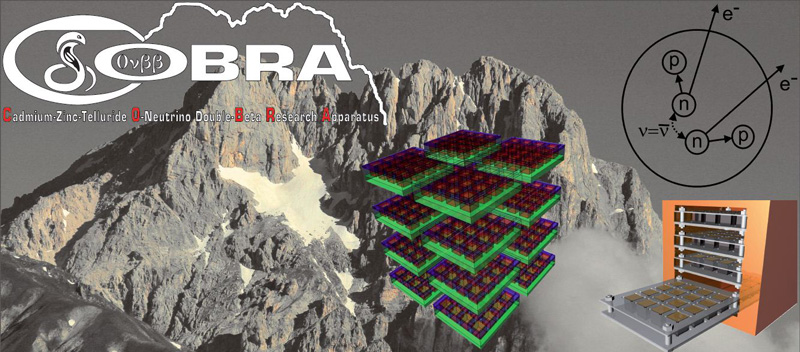Cadmium Zinc Telluride 0-Neutrino Double-Beta Research Apparatus
It is the last elementary particle whose rest mast could not be measured yet, and because it is neutral it is also the only fundamental particle that may be its own anti-particle.
Observation of neutrinoless double beta decay can clarify both important questions at once. But the expected half-life of more than 1025 years for this decay is an ambitious challenge to experimental physics. Currently first experiments are under commissioning that will be able to probe this magnitude of half-lifes. If they succeed, it will be important to verify the results with other experiments using different isotopes and different approaches. If they do not succeed, again new approaches will be required.
COBRA provides the necessary properties to be an excellent candidate for such a successive experiment. It uses CdZnTe room-temperature semiconductor detectors that contain several double beta decay candidate isotopes, among them also beta+ emitters and two of the most promising isotopes, 130Te and 116Cd. 116Cd has a decay energy that lies even well above the naturally occurring gamma background. The comparatively new semiconductor material CdZnTe has received more and more interest in recent years. Consequently, there has been major progress with these detectors and an end of the boost of this technology is not conceivable.
The experiment is located in the largest underground laboratory in the world for experiments in particle physics, particle astrophysics and nuclear astrophysics, 120km North-East of Rome, in the Gran Sasso National Laboratory LNGS. The laboratory is built approximately halfway through a 10.4km tunnel that passes underneath the Corno Grande mountain (2912m above sea level) , which is part of the Apennine mountain range. The quantity of rock above the laboratory is about 1400 m, which corresponds to 3600 m.w.e. of shielding against cosmic rays.
A brief history of the Neutrino
 "I have done a terrible thing.
I invented a particle that cannot be detected."
"I have done a terrible thing.
I invented a particle that cannot be detected."
W. Pauli
 Among the particles of the Standard Model of Particle Physics, neutrinos play a special role.
Among the particles of the Standard Model of Particle Physics, neutrinos play a special role.
They are the only elementary particles which do not carry any charge.
Therefore they only take part in the electroweak and gravitational interaction. Hence, neutrinos hardly interact with matter. Since neutrino interactions are delicate to be detected, comparably extensive experiments and detectors are required.
In fact, not the neutrino itself, only the other particles involved in the rare interactions are detected, and therefrom, the involvement of the neutino is concluded.
At the beginning of the 20th century, conservation of energy and momentum seemed to be violated by the weak β--decay of a neutron into a proton, an electron and an anti electron neutrino. The energy spectrum of the resulting electron is continuous.
Simply caused by the fact that only the electron and the proton could be detected, a fixed energy of a two body decay was expected. Thus, conservation of energy and momentum seemed to be violated. The problem was solved by Pauli in 1930 by suggesting a three body decay under the assumption of a neutral not yet known particle.
The name 'neutrino' for this particle was introduced later by Fermi.
Due to the extremely low interaction probability of the neutrino, it took more than 25 years until it's existence could be confirmed experimentally by Cowan and Reines in 1956.
Although the neutrino has been the subject of many experiments, important properties are not known yet. In the SM, the neutrino is described as an uncharged and massless Dirac particle. It belongs to the elementary particle family of leptons and occurs in three types, so called flavours: the electron neutrino, the muon neutrino and the tau neutrino. As Dirac particle, it appears as neutrino and anti-neutrino. Due to the fact that neutrinos do not carry any charge, it is also possible that they are their own antiparticles, so called Majorana particles Whereas the Dirac particle assumption of the SM could neither be confirmed nor disproved yet, it has been shown that the neutrino restmass is not vanishing by the Super-Kamiokande- and the SNO-Experiments. They observed the time-dependent change of the neutrino flavour which implies a neutrino rest mass.
